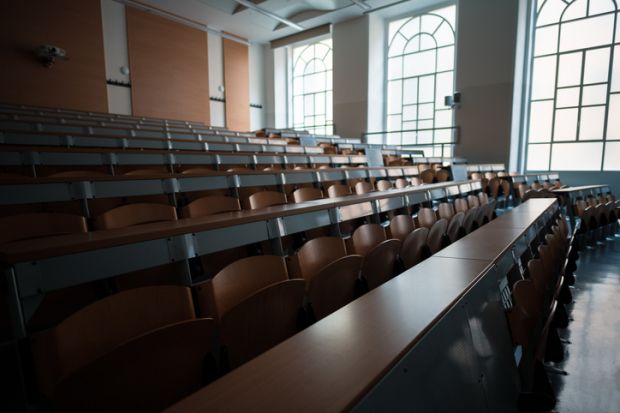US undergraduate enrolment fell another 1.1 per cent this semester, although the annual decline has slowed to pre-Covid levels, helped by gains among historically black institutions and dual-enrolled high school students, preliminary nationwide data show.
The initial tally for the current academic year by the National Student Clearinghouse Research Center affirms long-term concern for the sector, with the nation’s total undergraduate population now down an estimated 7 per cent from autumn 2019 – just before the pandemic – to autumn 2022.
“I certainly wouldn’t call this a recovery” for US higher education, said Doug Shapiro, the executive director of the Clearinghouse, part of a non-profit organisation that collects and analyses data on behalf of the sector.
“We’re seeing smaller declines,” Dr Shapiro said, referencing the new data, in which 63 per cent of US degree-granting institutions have so far reported their latest figures to the Clearinghouse. “But when you’re in a deep hole, the fact that you’re only digging a tiny bit further is not really good news.”
All major categories of US higher education were hit by enrolment declines, according to the initial Clearinghouse data. Among undergraduate institutions, the losses, as compared with autumn 2021, appear to be 1.6 per cent at public four-year campuses, 0.9 per cent at private non-profits, 2.5 per cent at private for-profits, and 0.4 per cent at community colleges.
The main positive sign for community colleges is dual enrolment – the growing tendency of secondary students taking college courses while still in high school – which registered an 11.5 per cent gain this autumn.
But traditional freshers – a critical measure for long-term enrolment – declined by 1.5 per cent, even faster than the overall 1.1 per cent drop. The freshmen losses totalled 3.1 per cent at private four-year non-profit institutions, 2.4 per cent at public four-year campuses, and nearly 1 per cent at private for-profits.
Postgraduate student enrolment also declined, by 1.5 per cent, the Clearinghouse said.
“The rate of decline is lower than it’s been,” Dr Shapiro said. “But after two straight years of historically large losses in student enrolments, it’s particularly troubling that the numbers are not climbing back at this point, especially among freshmen.”
The malaise is especially surprising, Dr Shapiro conceded, in the light of reports in recent weeks and months showing encouraging gains in the numbers of US high school students submitting their federal financial aid applications.
Dr Shapiro said he could not definitively explain why that activity did not translate into more students, given the accumulation of economic and personal struggles across the country, although he suggested the discrepancy could be due in part to the growing tendency of high schools to require their students to submit the aid applications. “They might just be checking a box,” he said of such students.
Either way, Dr Shapiro said, the situation amounts to more than 2 million “missing freshmen” who would have been expected to start college during the pandemic, and have not yet returned to do so. Many of them, he said, do not appear through other data to be either employed or enrolled in college.
International student enrolment at US institutions appears from the preliminary data to be down 2.6 per cent this autumn at the undergraduate level, after a 6 per cent drop a year earlier, while postgraduate enrolment among foreign students is up 15.4 per cent.
The data do have encouraging news for historically black colleges and universities, which saw their enrolment gain an estimated 2.5 per cent this autumn, including 6.5 per cent increase among freshers. Other minority-serving institutions experienced declines similar to the average 1.1 per cent loss nationwide.
By race, the steepest undergraduate declines came among white students, down 3.6 per cent this autumn. Latino students gained 1.2 per cent, black students were down 1.5 per cent, and Asian enrolment contracted 0.8 per cent.
Female enrolment also continued a trend seen last year of faring worse than their male counterparts, said Mikyung Ryu, the director of research publications at the Clearinghouse. “That is across the board at every level of education,” Dr Ryu said, perhaps reflecting the uneven distribution between the genders of Covid-related stresses and expectations.
The nation’s elite universities, meanwhile, sailed above the fray. Highly selective institutions – those admitting less than a third of their applicants – increased their enrolment by only about 0.5 per cent this autumn, in what Dr Shapiro described as largely a voluntary recalibration of their decision the previous year to add somewhat more students than usual. Institutions at all other levels of selectivity lost students, he said. “The declines”, he noted, “grew more steeply the farther down the scale you went.”
Register to continue
Why register?
- Registration is free and only takes a moment
- Once registered, you can read 3 articles a month
- Sign up for our newsletter
Subscribe
Or subscribe for unlimited access to:
- Unlimited access to news, views, insights & reviews
- Digital editions
- Digital access to THE’s university and college rankings analysis
Already registered or a current subscriber? Login








